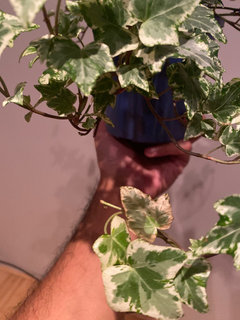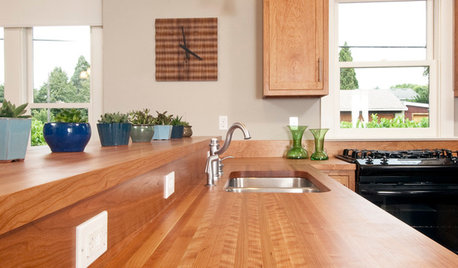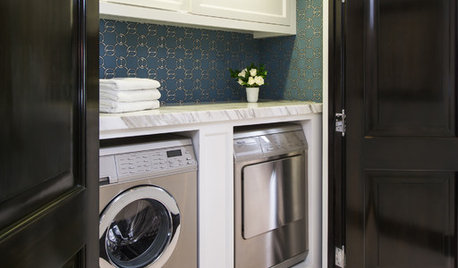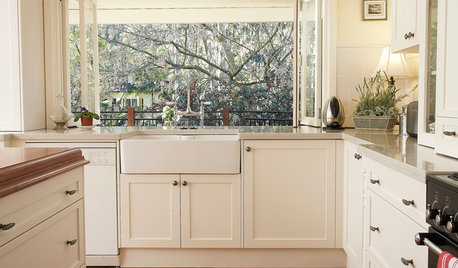I was wondering about 'flushing'?
I have read about it, know the whys and how to, but I cannot find anywhere where it says when you should flush it.
All my plants get distilled or water from the de-humidifier (they REALLY like the de-humidifier water) so is it necessary for me to flush them?
I don't have any plans to do it in the near future, I was just wondering when you know they need it. Or is it a maintance thing..
thanks in advance.
Comments (23)
whip1 Zone 5 NE Ohio
12 years agolast modified: 9 years agoI "flush" my plants every time I water. All of my pots have drainage holes, and when I water, I water enough so that a lot of water drains out the bottom.
tapla (mid-Michigan, USDA z5b-6a)
12 years agolast modified: 9 years agoMe too, Whip.
The main reason plants need flushing is to prevent or remedy the accumulation of salts from fertilizers and tap water that results from improper watering, that is to say from watering in small sips so no (or very little) water exits the drain when you water. As these salts accumulate, it makes it increasingly difficult for the plant to take up water and the nutrients dissolved in water. Many of the plants people post photos of that are in massive collapse are the result of either over0watering or an accumulation of salts in the soil, and these maladies go hand in hand as both are inherent issues with overly water-retentive soils.
If you're using water that is deionized, your risk is much lower. To a large degree, you CAN get away with watering in sips with little ill effect, unless you're using a fertilizer with a ratio that varies widely from that which plants actually use.
I think 5-10-5 is a popular fertilizer, often labeled for use on houseplants. Plants use on average about 6X more N than P, but in the 5-10-5 you find twice as much P as N. The ideal amount of P to 5 parts of N would be about .8 or 8/10 of 1 part, so the fertilizer appears to supply 12.5X more P than the plant needs as a function of N. Actually, there is a factor we need to take into consideration and when the calculation is done we'll find that 5-10-5 supplies a little less than 6X the P the plant needs.
What happens to the excess P if you don't flush the soil? Obviously, your plant runs out of N before it runs out of P, so you fertilize and increase the amount of excess P in the soil. Soon, the excess P begins to make it difficult for the plant to take up iron and manganese (known antagonists of P) and the plant turns a little chlorotic (yellow - a known symptom of iron deficiency) so you think your plant needs more fertilizer and you add another dose. Soon, your plant is sick and you don't know why.
Going back a few steps ..... IF you were using a soil that allowed you to flush the soil when you water, this never would have occurred. Too, because you can see how the ratio of nutrients in the soil becomes skewed, flushing the soil at intervals (if you can't/don't do it when you water) is sort of like hitting the 'reset' button. It washes most of the solubles from the soil and lets you start with a clean slate. ANY excess of any nutrient in the soil has the potential to be a limiting factor, and can be as bad for the plant as a deficiency.
There is a LOT you don't read in 'plant books', and a good measure of what you do read is wrong, repeated myth, or written under the burden of assumption. The author very often assumes what kind of soil you'll be using and offers instructions that only help you perpetuate the limitations you'll be working under.
You pose a good question. Why ISN'T the accumulation of salts in the soil addressed in plant books, especially when the problem is prevalent in almost epidemic proportions? It may not be as prevalent in forum settings because we're aware of it, and how to water is widely discussed; but I get to see people's plants when they bring them to my business for help, and when I talk to various groups, and I can say that 'epidemic' is on the mark.
If you're using rainwater, snowmelt, distilled water, water from a dehumidifier, or RO water, and don't flush the soil when you water, I would probably flush the soil every 3-4 months. If you're using tap water, I'd do it monthly. Of course, if you're using a soil that allows you to flush each time you water, it's a non issue. I fertilize at low doses every time I water (in winter), and because of the soils I use and the way I water, salt accumulation is never a problem.
Al
Related Professionals
Essex Landscape Architects & Landscape Designers · Mitchellville Landscape Architects & Landscape Designers · Otsego Landscape Architects & Landscape Designers · Alexandria Landscape Contractors · Elgin Landscape Contractors · Brooklyn Park Landscape Contractors · Clearlake Landscape Contractors · Fairfield Landscape Contractors · Lorain Landscape Contractors · Pahrump Landscape Contractors · Rosemount Landscape Contractors · Tinton Falls Landscape Contractors · Wentzville Landscape Contractors · Linton Hall Interior Designers & Decorators · Mansfield Interior Designers & DecoratorsLamora
Original Author12 years agolast modified: 9 years agowhip & tapla :)
So basicly, if I water untill water is just starts coming out of the bottom of the planter, and I do, I don't really need to worry about it? or does it need to drain a lot?
Sould I feed low dose every time I water since it does drain out? I do have some liquid feed, but use it rarely. When I do, I cut it in half, (as recommended by some)
Thanks so much for the replies-- not too worried about it now.
Was going to say/ask something else - phone rang and now I can't remember what it was. Getting old I guess- :/(sigh)
tapla (mid-Michigan, USDA z5b-6a)
12 years agolast modified: 9 years agoThis is something else you're unlikely to find in a book, but the ideal way to water houseplants is to wait until the soil is nearly dry - this is to say quite dry but not so dry drought stress becomes an issue. You can apply this to succulents as well, which should not be allowed to go completely dry. Then, apply enough water so the soil is saturated and perhaps a slight dribble appears at the drain hole. Wait about 10 minutes and water again, applying enough water so 15-20% of the total volume of water applied in both applications exits the drain hole. If there is a collection saucer, the water that exits the pot should not touch the bottom of the pot, lest it and the salts in it find a way back into the soil.
You needn't be as concerned about this because you're using deionized water, which means it's almost entirely free of dissolved solids (salts). If you want your plants to be as unencumbered as possible in their ability to take up water, keeping the salt level in the soil as low as possible w/o it being so low there are nutrient deficiencies is a requirement.
Are these steps necessary? No. We're all free to do as we please. Some may say their plants are perfectly healthy in the same commercially prepared soil for X number of years and they water in small sips whenever I feel like it and disregard every other tenet that constitutes sound practice, but there's a difference between suggesting what you can get away with and what practices will offer your plants greater opportunity to grow to their potential. There's a large difference that demands some attention to detail when you crossover from keeping plants alive to keeping plants that thrive.
For new growers, if they can get their plants in a favorable soil that allows them to water properly and promises not to be limiting, institute a sound nutritional supplementation, and find the right light for their plants - 90% of what you need to know is already behind you.
You, are a little unique, in that because you are using deionized water you CAN water in sips for much longer than it would be prudent if you used tap water. If you WANT to use a commercially prepared soil based on peat and water in small sips to prevent root rot issues, you can do that more effectively than growers who use tap water. Still, because of the fertilizer ratio becoming skewed as I mentioned above, it is a very good idea if you flush the soil regularly.
It's hard to beat the combination of fast draining soils and fertilizing regularly with low doses of fertilizer each time you water, but you can't do that if you're watering in sips. That tack demands that you flush the soil regularly or risk salt build-up. If you're going to continue to water as you are. I might suggest something like this:
Fertilize with a half dose of a 3:1:2 ratio soluble fertilizer in Mar and Apr. Flush the soil in May & fertilize the next time the plant needs water after that and again in Jun. Flush the soil in Jul & repeat through Oct. Then, eliminate every other fert application until next Apr, but DO flush the soil a time or two during winter.
I hope you took all that in. If not, let me know if something isn't clear.
Al
Lamora
Original Author12 years agolast modified: 9 years agoThanks Al-- taking notes ;)
The reason I don't use tap water is because it just doesn't taste good to me. If we could afford it, I wouldn't even give it to my pets.When I first got my Spider plant, it was not doing good at all, got on here and ppl said distilled or water from a dehumidifier would work best, besides rain water. And so I switched to distilled, and my Spidy came out of it real fast. So after that, I only use the 2 types of water now on all my plants. (I really miss Preston water-straight out of the tap, cold and clean)
Anyway, I usually do wait till they are almost completely dry, I put a long stick in it to see how wet the bottom is before I water. Kinda like a knife in a cake. If it is dry, or almost dry, it gets a drink. It depends on the plant, of course, but they average between 1-2wks. I just watered them this weekend. So within the next 2 weekends, I will feed them and follow your suggestion.
One plant isn't growing as well as I thought it would, but it isn't dying either. It was pretty sick when we got it to begin with,(potho,I think) baby starter that the cat got a hold of, but there are no new leaves on it and it just "stays" the same. It has real good roots, so IDK why it isn't growing. Maybe some "food" would help it. And Spring-- someday it will actually be here.
Al, thanks for all the info, it will seep in.
I'm trying to get into college this Spring, take a computer course, and all I can think if is "if I can't grasp/remember all this, how will I do in school??" But I am trying, and I love learning. Now whether or not it stays in my head is another story all together! lol
thanks again :)
tapla (mid-Michigan, USDA z5b-6a)
12 years agolast modified: 9 years agoI'm a pretty good judge of people, Lamora, and I can tell you like learning, which is one of the reasons I'll try to help whenever I can. Don't be hesitant about asking for any clarifications if something doesn't make sense.
What's the pothos's history? How long have you had it and have you fertilized it?
Al
Lamora
Original Author12 years agolast modified: 9 years agoI THINK it is a pothos, not sure. It looks like my Philodendron "Brasil" but with no yellow in it. Correct me if I'm wrong. I want to get these names right. :)
Well my daughter had it, she has a very long viney plant, when she moved it part of the vine broke off, or the kitten tore it off, one or the other. She put it in water for a few weeks, then gave it to my DH. He kept it in water for a few more weeks then put it in soil.(it did have roots then) We fertilized it then, and I think only once after that.
He put it in a 4" pot, I seen that it has real good roots. Not dried out or mushy, they look good from what I know of roots.This was all last Summer. at least 6 mths now. It had only 3 leaves on it then and it has 3 leaves on it now. It isn't growing new leaves or getting any bigger, but it is green and standing on its own. Looks healthy enough, (but sad cuz the leaves were chewed up by the cat)
I was just thinking that for the kind of plant it is, it would have grown a lot more than it has. Even with the bad start. Is there something I can do for it to make it want to grow?
Marjie
tapla (mid-Michigan, USDA z5b-6a)
12 years agolast modified: 9 years agoDo you think the pot is full of roots and the plant is root bound?
Plants have their own rhythms ans sense of time that is governed by day length. Many of our houseplants exhibit significantly reduced growth rates in the winter. Most start to show signs of increasing growth rates as March and the vernal equinox approach, which is when day length overtakes night length.
If your plant is healthy, it will grow when its internal rhythms tell it to grow, so don't worry. The best thing you can do for your plants is to provide the best cultural conditions you possibly can - they're programmed (genetics) to do the rest.
If your plant is small enough, it wouldn't hurt to flush the soil thoroughly with tap water, then fertilize with a half strength dose of a 3:1:2 ratio fertilizer, like MG 12-4-8 or 24-8-16. I use Foliage-Pro 9-3-6, also a 3:1:2 ratio fertilizer because it has ALL the essential nutrients, including calcium and magnesium, usually missing from other soluble fertilizers, and it gets more than 2/3 of its nitrogen from nitrate sources, which is very helpful in keeping low light plants from stretching out.
Did you read any of the recent threads where I discussed flushing the soil and how to rid the soil of excess water after you're done - in case you think your soil retains too much water?
Al
Lamora
Original Author12 years agolast modified: 9 years agoHi Al.. no the plant is defiantly not root bound. I re-soiled it (all of my plants actually,except for my Spider Plant) about 2wks ago, new soil with 5pt bark, 2pt perlite and 1pt soil.
The root in question isn't big at all, but it looks good. The pot is a good size for it, I think. I can send a pic if that would help.Where are your threads on flushing? I haven't come across them.. not sure where to look. I will read them if I can find them tho.
thanks again :)
Marjie
tapla (mid-Michigan, USDA z5b-6a)
12 years agolast modified: 9 years agoI'll see if I can find something to copy/paste about flushing, but it almost certainly doesn't need it if you just repotted 2 weeks ago. Did the soil you used say it had fertilizer in it? and have you fertilized since you repotted? if yes, with what?
Al
rhizo_1 (North AL) zone 7
12 years agolast modified: 9 years agoSomething that I don't 'think' has been mentioned in this thread is that if you don't drench the container at least every once in a while...some potting mixes, especially those that are mostly peat, will develop dry pockets that begin to repel water. The water that you do apply ends up following little channels so that it can exit the pot quickly, leaving large portions of the soil/root volume dry as a bone. Roots will die under those conditions.
Lamora
Original Author12 years agolast modified: 9 years agoHi Al.. that was stupid of me.. didn't even think about fertilizing them after re-potting. Makes a whole lot of since to do it at that time. So no-- I haven't. My bad :(
The fertilizer I have is Schultz Plant Food- 10-15-10.. 7 drops per qt. It says for feeding every time you water, but someone said that was too much. so I was planning on fertilizing once a month or so. half strength.. does that sound ok?
The soil is MG and it says it has fertilizer for 6mths in it already.
Can all plants be fertilized the same way? or do they have different needs in that area.
Right now they are all soaking up the sun coming through the window, all but the Hoya, but he is close enough to feel it. First real sunshine we've had for months! Hope it don't hurt them any. And I hope it stays a while.
Marjie
tapla (mid-Michigan, USDA z5b-6a)
12 years agolast modified: 9 years agoDon't be hard on yourself. You're just learning & deserve a break. ;-) I would hold off on fertilizing for now, and perhaps start supplementing what's in the soil with some low dose applications of fertilizer in May or Jun.
How you best approach fertilizing depends much more on your watering habits and soil choice than it does on plant type or any other factor. Surprisingly, all plants use roughly the same ratio of nutrients, some plants just use more nutrients overall than others; so in some ways you can fertilize all plants the same (I do), but that has to be qualified because different soil choices and watering habits require different approaches to fertilizing, if you want to get the most from your plants.
No matter how you arrive at the goal, the best fertilizer program is centered around providing all the nutrients plants normally get from the soil in the same ratio as that used by plants, at a concentration high enough to prevent nutritional deficiencies but low enough so it's not difficult for the plant to take up water.
The faster/better your soil drains, the easier this goal is to achieve. When you're watering copiously, so you're saturating the soil and salts are being flushed from the soil when you water, you can fertilize at low doses every time you water. In spite of what some growers might think, this is actually the most effective way to fertilize, because it so easily allows you to achieve the goal. As your soil becomes more water retentive to the point that you CAN'T flush the soil without risking root rot or compromised root function, there are added obstacles to overcome that make it difficult to fertilize properly.
It's good to remember that growing in containers is MUCH closer to hydroponics than it is growing in the garden. Most growers think they need that rick, black, composty-looking soil that holds tons of water, or their plants won't grow. Nothing could be farther from the truth.
Perched water (saturated soil) inhibits root function - period. Read my offering at the embedded link for more, and an analogy. Roots don't work well unless they get plenty of air, so soils that have areas of saturation in them are going to limit your plant's potential. If we can't breathe, we won't function well, and plants are the same in that regard.
If you missed what Dori said, skip up a few posts and reread it. What she offered is another reason its always better to use a soil or devise a plan that allows you to water thoroughly every time you water. I'd love to see you get into that habit, since you're pretty new to growing. It's much better to learn to do things the ideal way than to try to make a less than ideal way work.
Sunburn CAN be an issue if the plant is suddenly exposed to bright light when it's not acclimated to that intensity, and it can occur when light intensity is greater than the plant is genetically programmed to tolerate, but most of the time what is attributed to sunburn (houseplants) is actually from heat damage due to lack of air movement. Your plants will tolerate a light more light exposure if you eliminate the risk of heat build-up with a fan on particularly sunny days.
Al
Lamora
Original Author12 years agolast modified: 9 years agoSunburned plants-- been there-- done that :( Put them outside in the morning, then FORGETTING about them!! all wilty,brown and dry by the time I remembered them.. but I guess they forgave me, came out of it just fine. Scared me tho, I thought I had killed them! They don't go outside unless I am with them anymore-- just like my dog-- lol
They were fine yesterday by the window, sun didnt last long.
I have noticed something about my new "Bromeliad- (Tillandsia"?) When I watered it last time, the water that came out of the bottom was yellowish, and the roots are coming out of the bottom. I was told to wait a while before ropotting since it had flowers on it,(flowers are gone now) when can I re-pot it? or can I just flush it? The yellowish water has me concerned.
When I do flush, is "tap" water good for that? that has me a bit confused since the tap water has all that stuff in it that I wanted to keep away from... or distilled water for flushing. I just want to be clear on it.. :)
Thanks again
Marjorietapla (mid-Michigan, USDA z5b-6a)
12 years agolast modified: 9 years agoSome of the stuff in tap water can be good for plants, but you've heard the saying 'the poison is in the dose'? Too much of what CAN be a good thing, is a bad thing, when it comes to what's in the soil. Keeping in mind what I said about fertilizing upthread just a little, the best fertilizer program is centered around providing all the nutrients plants normally get from the soil in the same ratio as that used by plants, at a concentration high enough to prevent nutritional deficiencies but low enough so it's not difficult for the plant to take up water, it's easy to see that anything EXTRA in the soil solution (the water in the soil) that the plant can't use is not a good thing. This doesn't mean that because there are dissolved solids in our tap water that we need to panic. Yes, their presence isn't ideal, but now you realize their there and can put in place a plan to minimize or eliminate their effect on your plant.
The way you can do that, is to flush your soil regularly (as in every other month or so), or to adopt a soil that allows you to flush out accumulating salts every time you water. The problem with the later is that that can be difficult when using a water retentive soil, which is why it's no secret that I'm a strong advocate of using highly aerated soils for the reason we're discussing, and for several other advantages they offer the grower and plants over what heavier (more water-retentive soils offer).
Try to remember you want your soils to be damp and not wet, so keep your watering hand restrained until you're sure your plants need water. I wouldn't be too concerned about yellow water unless your plant gives signals it's faltering.
There is no reason you can't flush the soil of your plants now if you suspect they might have a lot of salt build-up in the soil. I would wait though, to repot. Most houseplants decline in the winter and move into spring with energy levels considerably reduced from what the were in fall and what they will be in summer. Plants recover from major work, like repotting and root pruning or major pruning, when their energy levels are high. They are much more resistant to disease and insect predation when energy levels are high, too. If you repot (different from potting up) or prune hard when the plant is weak (winter/spring) the added stress weakens the plant even more and leaves the plant vulnerable longer. It also ensures a longer recovery period. Potting up in spring is no problem, but potting up is a limiting practice where repotting is not. Growth and vitality are impacted by tight roots and potting up doesn't alleviate the effects of tight roots.
When you do flush, you can use tap water. I bet more than 95% of us use tap water for our plants. You can even use it with no problems to water regularly, like most of us do. There is an advantage to using deionized water, but that advantage is pretty much negated if you flush your soil on a schedule or use a fast draining soil that allows you to flush the soil when you water. Tap Water isn't the end of the world, and doesn't equate to an immediate problem. Paying attention to not letting what's in tap water build to the point that it eventually becomes a problem is just good insurance for you and your plants.
Al
Lamora
Original Author12 years agolast modified: 9 years agoAl- thanks again, this helps a lot, the tap water thing. I understand a lot better now. :) (yes, I am sometimes slow in learning, I'm a "hands on" type of person. Seeing and doing is better then reading, for me anyway. but I try, and that is all that counts.)
So I won't worry so much about using tap water for flushing or watering on occasion. That makes me feel better.
I did flush my one plant.(Tillandsia w/tap water)that's the one that had yellow water coming out of the bottem. But the yellow wasn't there today. All clean and clear.. :) also fed it very low dose fertilizer. It has 2 new flowers on it today! very pretty plant.
Marjie
tapla (mid-Michigan, USDA z5b-6a)
12 years agolast modified: 9 years agoGood luck - Remember, "damp, not wet".
Al
rhizo_1 (North AL) zone 7
12 years agolast modified: 9 years agoSign me up as another who uses tap water almost exclusively, with no problems. I also (say it isn't so, Dorie) use that tap water straight out of the faucet, cold and full of horrid chlorine. lol
Dorietapla (mid-Michigan, USDA z5b-6a)
12 years agolast modified: 9 years agoI let the water I use for houseplants come to room temperature before I use it. I don't know why. Habit, I suppose. I've made it a point to ask a good number of people with a bunch of letters after their names why we shouldn't water with cold water, and I've never got an answer other than, "There is no reason I can think of". I water everything that is sited in the baking sun with cold water from the hose, too - with no ill effects I've ever been able to discern.
Only in water purification systems that are throwbacks to the 50s & 60s will you find a volatile form of chlorination. This is because of it's short half life. Newer forms of chlorination use chloramine, which doesn't gas off like the previously used compounds of chlorine. The fluoridation process (of drinking water) has always used a compound that is nonvolatile, so it too, remains in any water left out to rest for any length of time.
In fact, since some evaporation will occur while water is resting (especially if it is in a container that has a lot of air exposure at its opening - like a pan or bucket) the level of chlorine, fluorine, and other solutes becomes more concentrated as water rests and a fraction of its volume evaporates, leaving the solutes behind.
Al
Jaku
4 years agoHi I have also issue with my Calatheas and English Ivy browning tips and seems like everyday one leaf of the ivy dies out.

Jaku
4 years agoIt was doing well until we moved to different house few days ago. It has more bright light now but it seems like leaves are not happy; it’s indirect light still away from the window (1.5 feet away).
Will do and I have well drained soil and don’t overwater. I mixed my soil with perlite, bit of compost and then coir peat. I use a measuring tool to see if the soil is wet or dry.
gardengal48 (PNW Z8/9)
4 years agoCan you explain your soil in a bit more detail? There are a few things about it that don't quite jive with a durable, fast draining soil mix.........



















gardengal48 (PNW Z8/9)